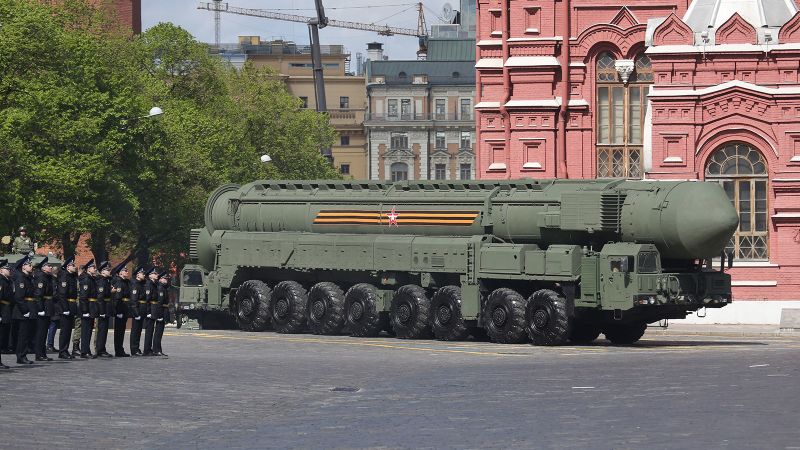London
CNN
—
Nuclear-armed countries are strengthening their arsenals and several have made ready new nuclear-armed or nuclear-capable weapons systems amid rising geopolitical tensions, a new report has found.
The nine nuclear states – the United States, Russia, the United Kingdom, France, China, India, Pakistan, North Korea and Israel – have continued to modernize their weapons stockpiles, with China, for the first time, possibly deploying “a small number of warheads on missiles during peacetime,” the Stockholm International Peace Research Institute (SIPRI) said in a new report published Monday.
“While the global total of nuclear warheads continues to fall as Cold War-era weapons are gradually dismantled, regrettably we continue to see year-on-year increases in the number of operational nuclear warheads,” the institute’s director Dan Smith said. “This trend seems likely to continue and probably accelerate in the coming years and is extremely concerning.”
In January 2024, the total global stockpile of warheads was estimated at 12,121, of which about 9,585 were in military stockpiles for potential use, according to SIPRI. The think tank estimates that 3,904 of those warheads were deployed with missiles and aircraft, or 60 more warheads than in January 2023.
The majority of the deployed warheads, about 2,100, were kept “in a state of high operational alert on ballistic missiles,” SIPRI said. While nearly all of those warheads belonged to the US and Russia, for the first time China is also believed to have some warheads on high operational alert.
Russia and the US together own nearly 90 percent of all nuclear weapons and the number of useable warheads they possessed in 2023 remained stable for the most part, according to the Swedish think tank. However, Russia is estimated to have deployed about 36 more warheads with operational forces than in January 2023.
“Transparency regarding nuclear forces has declined in both countries in the wake of Russia’s full-scale invasion of Ukraine in February 2022, and debates around nuclear-sharing arrangements have increased in saliency,” the Swedish think tank said.
Russia and the US also possess more than 1,200 warheads each that have been previously retired from military service, and are gradually being dismantled, it said.
The institute said despite “public claims made in 2023” that Russia had deployed nuclear weapons on Belarusian territory, “there is no conclusive visual evidence that the actual deployment of warheads has taken place.”
The size of China’s nuclear arsenal is estimated to have increased from 410 warheads in January 2023 to 500 in January 2024, “and it is expected to keep growing,” according to SIPRI.
“China is expanding its nuclear arsenal faster than any other country,” said Hans M. Kristensen, associate senior fellow with SIPRI’s Weapons of Mass Destruction Program. “But in nearly all of the nuclear-armed states there are either plans or a significant push to increase nuclear forces.”
China could potentially have as many intercontinental ballistic missiles (ICBMs) as Russia or the US by the end of the decade, but Beijing’s stockpile of nuclear warheads is expected to remain much smaller compared to their stockpiles.
North Korea’s military nuclear program continues to be “a central element of its national security strategy,” and SIPRI estimates the hermit kingdom possesses about 50 warheads and enough fissile material to reach up to 90 warheads, numbers that represent “significant increases over the estimates for January 2023.”
In 2023, North Korea appeared to have carried out its first test of a short-range ballistic missile from a rudimentary silo and completed the development of at least two types of land-attack cruise missile (LACM) designed to deliver nuclear weapons, according to SIPRI.
“Like several other nuclear-armed states, North Korea is putting new emphasis on developing its arsenal of tactical nuclear weapons,” said Matt Korda, Associate Researcher with SIPRI’s Weapons of Mass Destruction Program. “Accordingly, there is a growing concern that North Korea might intend to use these weapons very early in a conflict.”

The Swedish think tank said the wars in Ukraine and Gaza have further weakened nuclear diplomacy on the global stage.
In 2023 Russia suspended participation in the Treaty on Measures for the Further Reduction and Limitation of Strategic Offensive Arms (New START), the last remaining nuclear arms control treaty limiting Russian and US strategic nuclear forces, while in response the US also stopped sharing data.
Moscow has continued to make threats involving the use of nuclear weapons in light of Western aid for Ukraine, and in May 2024 carried out tactical nuclear weapons drills close to the Ukrainian border, SIPRI said.
“We have not seen nuclear weapons playing such a prominent role in international relations since the Cold War,” said Wilfred Wan, the director of SIPRI’s Weapons of Mass Destruction Program. “It is hard to believe that barely two years have passed since the leaders of the five largest nuclear-armed states jointly reaffirmed that ‘a nuclear war cannot be won and must never be fought’,” he said.
Furthermore, an agreement between Iran and the US in June 2023 “seemed to temporarily de-escalate tensions between the two countries,” but the start of the Israel–Hamas war in October “upended the agreement, with proxy attacks by Iran-backed groups on US forces in Iraq and Syria apparently ending Iranian–US diplomatic efforts,” SIPRI said.
The Israel–Hamas war also “undermined efforts” to engage Israel in the Conference on the Establishment of a Middle East Zone Free of Nuclear Weapons and Other Weapons of Mass Destruction, the think tank said.








:max_bytes(150000):strip_icc()/roundup-writereditor-loved-deals-tout-f5de51f85de145b2b1eb99cdb7b6cb84.jpg)


